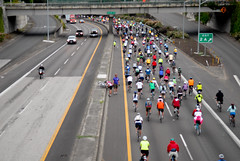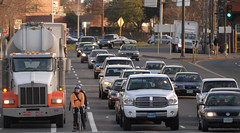The City of Portland announced a collaboration with IBM today to “better understand the dynamic behavior of cities.”
The initiative is part of IBM’s Smarter Cities project that looks to use computer modeling and data analysis to inform city planning and policies. Or, as IBM Chairman Samuel J. Palmisano puts it, “Thanks to supercomputers, we can turn mountains of data into insight.”
As part of the City of Portland’s long-range planning effort known as the Portland Plan, IBM developed a tool to model the relationships among the city’s core systems including the economy, housing, education, public safety, health, utilities, and transportation. They used 10 years of data to look 25 years into the future.
Will smarter data and understanding of how transportation policy impacts other aspects of city life lead to more political momentum for bike-specific infrastructure? Is a “smarter city” a more bicycle-oriented city? If you’ve ever seen the daily traffic snarls in and around downtown Portland, you know that something has to change. But, is it data analysis that will help our politicians and policymakers finally reach beyond the low-hanging fruit and tackle our big transportation problems?
More funding and policy support for active transportation was used in an example by IBM in the press release about the partnership:
“… recently the City of Portland laid out plans to achieve a 40 percent reduction in carbon emissions by 2030, and an 80 percent reduction by 2050. The City already knew that shifting some trips away from driving to active forms of transportation, such as walking and biking, would be a part of how Portland meets its goals. However, when the IBM model was used to explore other relationships to active transportation, it revealed an interesting connection. The model reflects that, on average, obesity levels decline as more people walk and bike. Similarly, if obesity levels go down, active transportation becomes a more attractive option to more people. Essentially the tool highlighted a reinforcing feedback loop that could be used to jump start a continued cycle of improvement. Since shifting to walking and biking reduces driving trips, the obesity/active transport loop could be a self-reinforcing policy lever to address carbon goals.”
We’ve yet to hear of how and when the model will be used in Portland; but this is definitely something worth keeping an eye on.
For more, read an article published on Fast Company yesterday titled, “IBM Partners With Portland To Play SimCity For Real.”



